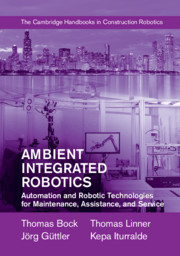 Ambient Integrated Robotics
Ambient Integrated Robotics Published online by Cambridge University Press: 09 July 2019
As society ages, the building stock needs to be upgraded. A proper Ambient/Active Assisted Living (AAL) implementation needs a holistic approach; consequently, the environment itself needs to be adapted to the new needs of its inhabitants. Spatially and functionally, homes, and generally the built environment, may not meet the requirements of the elderly anymore. Demographic changes and the effects of an aging society also affect buildings and the built environment. Rapid refurbishment processes, quick adaptation protocols, and appropriate maintenance procedures become a necessity in order to not disturb the elderly and provide them with comfortable and functional homes and spaces. This is the main motivation behind the message of this chapter, which deals with the issue of how to adapt the living built environment for the elderly by use of fast and unobtrusive procedures. Moreover, a method for the assessment of strategies for built environment upgrading for AAL (BeuAAL) in early stages is presented. This chapter will help encouraging several stakeholders to accomplish building renovations for the elderly using robotics and automated tools.
To save this book to your Kindle, first ensure no-reply@cambridge.org is added to your Approved Personal Document E-mail List under your Personal Document Settings on the Manage Your Content and Devices page of your Amazon account. Then enter the ‘name’ part of your Kindle email address below. Find out more about saving to your Kindle.
Note you can select to save to either the @free.kindle.com or @kindle.com variations. ‘@free.kindle.com’ emails are free but can only be saved to your device when it is connected to wi-fi. ‘@kindle.com’ emails can be delivered even when you are not connected to wi-fi, but note that service fees apply.
Find out more about the Kindle Personal Document Service.
To save content items to your account, please confirm that you agree to abide by our usage policies. If this is the first time you use this feature, you will be asked to authorise Cambridge Core to connect with your account. Find out more about saving content to Dropbox.
To save content items to your account, please confirm that you agree to abide by our usage policies. If this is the first time you use this feature, you will be asked to authorise Cambridge Core to connect with your account. Find out more about saving content to Google Drive.